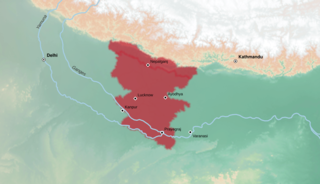
Modern Standard Hindi, commonly referred to as Hindi, is the standardised variety of the Hindustani language used as the official language of India alongside English. It is written in Devanagari script and is the lingua franca of North India. Hindi is considered a Sanskritised register of the Hindustani language, which itself is based primarily on the Khariboli dialect of Delhi and neighbouring areas. It is an official language in nine states and three union territories and an additional official language in three other states. Hindi is also one of the 22 scheduled languages of the Republic of India.

Hindustani is an Indo-Aryan language spoken in North India, Pakistan and the Deccan, and used as a lingua franca in both countries. Hindustani is a pluricentric language with two standard registers, known as Hindi and Urdu. Thus, it is also called Hindi–Urdu. Colloquial registers of the language fall on a spectrum between these standards. In modern times, a third variety of Hindustani with significant English influences has also appeared which is sometimes called Hinglish or Urdish.

The Indo-Aryan languages are a branch of the Indo-Iranian languages in the Indo-European language family. As of the early 21st century, they have more than 800 million speakers, primarily concentrated in Bangladesh, India, Pakistan, Sri Lanka, Maldives and Nepal. Moreover, apart from the Indian subcontinent, large immigrant and expatriate Indo-Aryan–speaking communities live in Northwestern Europe, Western Asia, North America, the Caribbean, Southeast Africa, Polynesia and Australia, along with several million speakers of Romani languages primarily concentrated in Southeastern Europe. There are over 200 known Indo-Aryan languages.

Gujarati is an Indo-Aryan language native to the Indian state of Gujarat and spoken predominantly by the Gujarati people. Gujarati is descended from Old Gujarati. In India, it is one of the 22 scheduled languages of the Union. It is also the official language in the state of Gujarat, as well as an official language in the union territory of Dadra and Nagar Haveli and Daman and Diu. As of 2011, Gujarati is the 6th most widely spoken language in India by number of native speakers, spoken by 55.5 million speakers which amounts to about 4.5% of the total Indian population. It is the 26th most widely spoken language in the world by number of native speakers as of 2007.

Marwari is a language within the Rajasthani language family of the Indo-Aryan languages. Marwari and its closely related varieties like Dhundhari, Shekhawati and Mewari form a part of the broader Marwari language family. It is spoken in the Indian state of Rajasthan, as well as the neighbouring states of Gujarat and Haryana, some adjacent areas in eastern parts of Pakistan, and some migrant communities in Nepal. There are two dozen varieties of Marwari. Marwari is also referred to as simply Rajasthani.
The Gujarati languages are a Western Indo-Aryan language family, comprising Gujarati and those Indic languages closest to it. They are ultimately descended from Shauraseni Prakrit.

Awadhi, also known as Audhi, is an Indo-Aryan language spoken in the Awadh region of Uttar Pradesh in northern India and in Terai region of western Nepal. The name Awadh is connected to Ayodhya, the ancient city, which is regarded as the homeland of the Hindu god Rama. It was, along with Braj, used widely as a literary vehicle before being displaced by Hindi in the 19th century.
Hindustani is one of the predominant languages of South Asia, with federal status in the republics of India and Pakistan in its standardized forms of Hindi and Urdu respectively. It is widely spoken and understood as a second language in Nepal, Bangladesh, and the Persian Gulf and as such is considered a lingua franca in the northern Indian subcontinent. It is also one of the most widely spoken languages in the world by total number of speakers. It developed in north India, principally during the Mughal Empire, when the Persian language exerted a strong influence on the Western Hindi languages of central India; this contact between the Hindu and Muslim cultures resulted in the core Indo-Aryan vocabulary of the Indian dialect of Hindi spoken in Delhi, whose earliest form is known as Old Hindi, being enriched with Persian loanwords. Rekhta, or "mixed" speech, which came to be known as Hindustani, Hindi, Hindavi, and Urdu, also locally known as Lashkari or Lashkari Zaban in long form, was thus created. This form was elevated to the status of a literary language, and after the partition of colonial India and independence this collection of dialects became the basis for modern standard Hindi and Urdu. Although these official languages are distinct registers with regards to their formal aspects, such as modern technical vocabulary, they continue to be all but indistinguishable in their vernacular form. From the colonial era onwards, Hindustani has also taken in many words from English, with an urban English-influenced variety emerging known as Hinglish.

The Hindi Belt, also known as the Hindi Heartland, is a linguistic region encompassing parts of northern, central, eastern, and western India where various Northern, Central, Eastern and Western Indo-Aryan languages are spoken, which in a broader sense is termed as Hindi languages, with Standard Hindi serving as the lingua franca of the region.

The Bhil languages are a group of Indo-Aryan languages spoken by around 10.4 million Bhils in western and central India as of 2011. They constitute the primary languages of the southern Aravalli Range in Rajasthan and the western Satpura Range in Madhya Pradesh, northwestern Maharashtra, and southern Gujarat. According to the 52nd report of the commissioner for linguistic minorities in India, Ministry of Minority Affairs, Bhili is the most commonly spoken language of the district of Dadra and Nagar Haveli constituting 40.42% of its total population. Bhili speakers are also significant in the states of Gujarat (4.75%), Madhya Pradesh (4.93%) and Rajasthan (4.60%).

Rajasthani languages are a branch of Western Indo-Aryan languages. It is spoken primarily in the state of Rajasthan and adjacent areas of Haryana, Gujarat and Madhya Pradesh in India. There are also speakers in the Pakistani provinces of Punjab and Sindh. Rajasthani is also spoken to a lesser extent in Nepal where it is spoken by 25,394 people according to the 2011 Census of Nepal.
Dramatic Prakrits were those standard forms of Prakrit dialects that were used in dramas and other literature in medieval India. They may have once been spoken languages or were based on spoken languages, but continued to be used as literary languages long after they ceased to be spoken. Dramatic Prakrits are important for the study of the development of Indo-Aryan languages, because their usage in plays and literature is always accompanied by a translation in Sanskrit.
Hindustani, also known as Hindi-Urdu, is the vernacular form of two standardized registers used as official languages in India and Pakistan, namely Hindi and Urdu. It comprises several closely related dialects in the northern, central and northwestern parts of the Indian subcontinent but is mainly based on Khariboli of the Delhi region. As an Indo-Aryan language, Hindustani has a core base that traces back to Sanskrit but as a widely-spoken lingua franca, it has a large lexicon of loanwords, acquired through centuries of foreign rule and ethnic diversity.
The Middle Indo-Aryan languages are a historical group of languages of the Indo-Aryan family. They are the descendants of Old Indo-Aryan and the predecessors of the modern Indo-Aryan languages, such as Hindustani (Hindi-Urdu), Bengali and Punjabi.

Caribbean Hindustani is an Indo-Aryan language spoken by Indo-Caribbeans and the Indo-Caribbean diaspora. It is a koiné language mainly based on the Bhojpuri and Awadhi dialects. These Hindustani dialects were the most spoken dialects by the Indians who came as immigrants to the Caribbean from Colonial India as indentured laborers. It is closely related to Fiji Hindi and the Bhojpuri-Hindustani spoken in Mauritius and South Africa.

Fiji Hindi is an Indo-Aryan language spoken by Indo-Fijians. It is an Eastern Hindi and Bihari language, considered to be a koiné language based on Awadhi that has also been subject to considerable influence by Bhojpuri, other Eastern Hindi and Bihari dialects, and Standard Hindi-Urdu. It has also borrowed some vocabulary from English, Fijian, Telugu, Tamil, Bengali, Punjabi, Gujarati, and Malayalam. Many words unique to Fiji Hindi have been created to cater for the new environment that Indo-Fijians now live in. First-generation Indians in Fiji, who used the language as a lingua franca in Fiji, referred to it as Fiji Baat, "Fiji talk". It is closely related to Caribbean Hindustani and the Bhojpuri-Hindustani spoken in Mauritius and South Africa. It is largely mutually intelligible with the languages of Awadhi and Bhojpuri, as well as with the Bihari languages of Bihar, Uttar Pradesh, Jharkhand, Madhesh, Koshi and Lumbini, and the dialects of Eastern Hindi of Uttar Pradesh, Madhya Pradesh, Chhattisgarh and Lumbini, but differs in phonetics and vocabulary with Modern Standard Hindi and Urdu.

The Western Hindi languages, also known as Midland languages, are a branch of the Indo-Aryan language family spoken chiefly in Haryana, western Uttar Pradesh and Bundelkhand region of Madhya Pradesh, in Northwest and Central India. The Western Hindi languages evolved from Sauraseni Prakrit. The most-spoken language in the Western Hindi language family is Standard Hindi, one of the official languages of the Government of India and one of the 22 Scheduled Languages of India.

The Eastern Hindi languages, also called East Central languages, are a branch of the Indo-Aryan language family spoken chiefly in Awadh region of Uttar Pradesh, Baghelkhand region of Madhya Pradesh, and Chhattisgarh, in Northern and Central India. Eastern Hindi languages evolved from Ardhamagadhi Prakrit.
The Eighth Schedule to the Constitution of India lists nationally recognised regional languages of the Republic of India. At the time when the Constitution was enacted, inclusion in this list meant that the language was entitled to representation on the Official Languages Commission, and that the language would be one of the bases that would be drawn upon to enrich Hindi and English, the official languages of the Union. The list has since, however, acquired further significance. The Government of India is now under an obligation to take measures for the development of these languages, such that "they grow rapidly in richness and become effective means of communicating modern knowledge." In addition, candidates sitting for an examination conducted for public service are entitled to use any of these languages as a medium to answer the paper.
Ardhamagadhi Prakrit was a Middle Indo-Aryan language and a Dramatic Prakrit thought to have been spoken in modern-day Bihar and Uttar Pradesh and used in some early Buddhist and Jain dramas. It was likely a Central Indo-Aryan language, related to Pali and the later Shauraseni Prakrit. The Eastern Hindi languages evolved from Ardhamagadhi Prakrit.











